ANTHROPOLOGY
Paper – II
Note : This paper contains fifty (50) objective type questions of two (2) marks each. All questions are compulsory.
1. Identify the “suspensory primate” from the following :
(1) Chimpanzee
(2) Tree-Shrew
(3) Gibbon
(4) Howler Monkey
2. The term “Anthropometry” was coined by
(1) Quetlet
(2) Martin & Saller
(3) Hrdlicka
(4) Georges Cuvier
3. The Boyd’s racial classification was based on
(1) Blood groups
(2) Anthropometry
(3) Dermatoglyphics
(4) DNA markers
4. Which one of the following is associated with the racial classification of the peoples of India ?
(1) S.R.K. Chopra
(2) S.S. Sarkar
(3) D.N. Majumdar
(4) P.C. Biswas
5. The principal objective of which article of Indian Constitution is to ban the practice of untouchability in any form ?
(1) Article 17
(2) Article 16(4)
(3) Article 19
(4) Article 25
6. Who among the following is not an affinal kin ?
(1) Ego’s husband’s sister
(2) Ego’s brother’s son
(3) Ego’s wife’s brother
(4) Ego’s wife’s mother
7. Which among the following is not a source of law ?
(1) Custom
(2) Religion
(3) Habits
(4) Judicial decision
8. Who, among the following, has propounded a ‘descent’ theory of kinship ?
(1) Rodney Needham
(2) Claude Levi-Strauss
(3) Marvin Harris
(4) A.R. Radcliffe-Brown
9. Which of the following is not considered as a geometric type of microlith ?
(1) Backed blade
(2) Trapeze
(3) Triangle
(4) Rhomboid
10. Which of the following is radiometric dating ?
(1) Archaeomagnetism
(2) Varve
(3) Thermo-luminescence
(4) Potassium-Argon
11. The characteristic features of Orangutans are
(a) They are found in Indonesia on the Islands of Sumatra and Borneo.
(b) They are also known as Pongo.
(c) They show extreme sexual dimorphism
(d) They were extensively studied by Jane Goodall
Codes :
(1) only (c) and (d) are correct.
(2) only (b) and (d) are correct.
(3) (a), (b) and (c) are correct.
(4) (a), (b) and (d) are correct.
12. Characteristic of multiple alleles are
(a) Multiple alleles occupy the same locus within the homologous chromosomes. But only one member of the series is present in a given chromosome.
(b) Crossing-over occurs in multiple alleles.
(c) Multiple alleles control the same character.
(d) In the multiple alleles, one is dominant and the rest are recessive or sometimes they are codominant :
Codes :
(1) (a), (c) and (d) are correct.
(2) (b), (c) and (d) are correct.
(3) only (a) and (b) are correct.
(4) only (a), (b) and (d) are correct.
13. The typical feature shown by a Klinefelter syndrome individual are :
(a) The male has one extra X-chromosome.
(b) He is highly fertile.
(c) Body hair is sparse.
(d) Female like breasts are there.
Codes :
(1) (a), (b), (c) are correct.
(2) (b), (c), (d) are correct.
(3) (a), (c), (d) are correct.
(4) (a), (b), (d) are correct.
14. Features of X-linked dominant inheritance are
(a) The trait is never passed from father to son.
(b) Mating of affected females and normal males produce 1/3 the sons affected and 1/2 the daughters affected.
(c) Both males and females affected but often an excess of females.
(d) Females less severely affected than males.
Codes :
(1) (a), (c) and (d) are correct.
(2) (b), (c) and (d) are correct.
(3) only (a), (b) and (c) are correct.
(4) (a), (b) and (d) are correct.
15. Which of the following are the examples of achieved status ? Use the codes :
(a) Elected membership of Parliament
(b) Professorship
(c) Lawyer
(d) Vice-chancellorship
Codes :
(1) (a), (b), (c) and (d) are correct.
(2) only (a), (b) and (d) are correct.
(3) only (a), (b) and (c) are correct.
(4) only (a) and (c) are correct.
16. Which of the following are considered as the characteristic features of Particularly Vulnerable Tribal Groups ? Use Codes :
(a) Pre-agricultural level of technology
(b) Extremely low literacy
(c) Stagnant or diminishing population
(d) Surplus level of economy
Codes :
(1) (a), (b) and (d) are correct.
(2) (a), (b) and (c) are correct.
(3) only (d) is correct.
(4) only (b) and (d) are correct.
17. Which of the following are the common characteristics of a ‘lineage’ and a ‘clan’ ? Use the codes :
(a) Both believe in real ancestors.
(b) Both believe in fictional ancestors.
(c) Both are social groups.
(d) Both believe in common ancestors
Codes :
(1) (a), (b) and (c) are correct.
(2) (a), (b), (c) and (d) are correct.
(3) only (c) and (d) are correct.
(4) only (a) and (b) are correct.
18. Which of the anthropologists are considered belonging to ‘German School of Diffusionism’ ? Use codes.
(a) F. Ratzel
(b) F. Graebner
(c) F.W. Schmidt
(d) G.E. Smith
Codes :
(1) (a), (b) and (d) are correct.
(2) only (a) and (b) are correct.
(3) only (c) and (d) are correct.
(4) (a), (b) and (c) are correct.
19. Which of the following scholars have worked in the Neolithic sites of North Arcot district ?
Use Codes :
(a) H.D. Sankalia
(b) R.B. Foote
(c) V.N. Mishra
(d) F.R. Allchin
Codes :
(1) (a) and (b) are correct.
(2) (b) and (c) are correct.
(3) (c) and (d) are correct.
(4) (b) and (d) are correct.
20. Which of the following Mesolithic sites are located on sand dunes ? Use codes :
(a) Tennevelly
(b) Bagor
(c) Sarai-Nahar-Rai
(d) Langhnaj
Codes :
(1) (a), (b), (c) are correct.
(2) (b), (c), (d) are correct
(3) (a), (c), (d) are correct.
(4) (a), (b), (d) are correct.
21. Given below are two statements, one is labelled as Assertion (A) and the other is labelled as Reason (R). Indicate your answers from the alternatives below :
Assertion (A) : Finger ball prints are unique in each and every individual.
Reason (R) : Fingerprints are not very useful in establishing the identity of a person.
In the context of the above two statements, which one of the following is correct ?
(1) (A) is correct, but (R) is wrong.
(2) Both (A) and (R) are correct.
(3) (A) is wrong, but (R) is correct.
(4) Both (A) and (R) are wrong.
22. Given below are two statements, one is labelled as Assertion (A) and the other is labelled as Reason (R). Indicate your answers from the alternatives below :
Assertion (A) : A captive study allows us to closely observe non-human primates up close and personal because they would not hide in dense trees for hours on end.
Reason (R) : However, we cannot manipulate the study group’s behaviour.
In the context of the above two statements, which one of the following is correct ?
(1) (A) is correct, but (R) is wrong.
(2) Both (A) and (R) are correct.
(3) (A) is wrong, but (R) is correct.
(4) Both (A) and (R) are wrong.
23. Given below are two statements, one is labelled as Assertion (A) and the other is labelled as Reason (R). Indicate your answers from the alternatives below :
Assertion (A) : Selection introduces new genes in a population.
Reason (R) : Mutation favours one of the two alleles.
In the context of the above two statements, which one of the following is correct ?
(1) (A) is correct, but (R) is wrong.
(2) Both (A) and (R) are correct.
(3) (A) is wrong, but (R) is correct.
(4) Both (A) and (R) are wrong.
24. Given below are two statements, one is labelled as Assertion (A) and the other is labelled as Reason (R). Indicate your answers from the alternatives below :
Assertion (A) : Very dark-skinned populations can be found in Africa, India and Melanesia.
Reason (R) : Populations from different parts of the world may have similar skin colours because they share a common environmental feature, namely, the intensity of sunlight exposure.
In the context of the above two statements, which one of the following is correct ?
(1) Both (A) and (R) are true and (R) is the correct explanation of (A).
(2) Both (A) and (R) are true, but (R) is not the correct explanation of (A).
(3) (A) is true, but (R) is false.
(4) (A) is false, but (R) is true.
25. Given below are two statements, one is labelled as Assertion (A) and the other is labelled as Reason (R). Indicate your answers from the alternatives below :
Assertion (A) : Economists believe that economic theories cannot be applied in ‘subsistence level economies’; nor could any economic theory be derived out of their studies.
Reason (R) : ‘Medium of exchange’ is found in subsistence level economies.
In the context of the above two statements, which one of the following is correct ?
(1) (A) is correct, but (R) is wrong.
(2) Both (A) and (R) are correct.
(3) (A) is wrong, but (R) is correct.
(4) Both (A) and (R) are wrong.
26. Given below are two statements, one is labelled as Assertion (A) and the other is labelled as Reason (R). Indicate your answers from the alternatives below :
Assertion (A) : Unilinear evolutionists believed in parallel development of human culture from savagery through barbarism to civilization.
Reason (R) : Unilever evolutionists believed in psychic unity of mankind.
In the context of the above two statements, which one of the following is correct ?
(1) (A) is correct, but (R) is wrong.
(2) Both (A) and (R) are correct and (R) is the correct explanation of (A).
(3) (A) is wrong, but (R) is correct.
(4) Both (A) and (R) are true, but (R) is not the correct explanation of (A).
27. Given below are two statements, one is labelled as Assertion (A) and the other is labelled as Reason (R). Indicate your answers from the alternatives below :
Assertion (A) : Kingdom is considered as a ‘stateless society’ because it does not hold the characteristics of a state.
Reason (R) : Characteristics of a state are as such, a defined territory, population, sovereignty and a government.
In the context of the above two statements, which one of the following is correct ?
(1) (A) is correct, but (R) is wrong.
(2) Both (A) and (R) are correct.
(3) (A) is wrong, but (R) is correct.
(4) Both (A) and (R) are wrong.
28. Given below are two statements, one is labelled as Assertion (A) and the other is labelled as Reason (R). Indicate your answers from the alternatives below :
Assertion (A) : In Euro-American societies Ambilineal descent system is prevalent.
Reason (R) : In Ambilineal descent, the members enjoy equal rights, duties and privileges from both father and mother sides.
In the context of the above two statements, which one of the following is correct ?
(1) (A) is correct, but (R) is wrong.
(2) Both (A) and (R) are correct.
(3) (A) is wrong, but (R) is correct.
(4) Both (A) and (R) are wrong.
29. Given below are two statements, one is labelled as Assertion (A) and the other is labelled as Reason (R). Indicate your answers from the alternatives below :
Assertion (A) : Amino-acid racemization is a relative method of dating.
Reason (R) : The method depends on principles on molecules that rotate polarized light to the left.
In the context of the above two statements, which one of the following is correct ?
(1) Both (A) and (R) are true and (R) is the correct explanation.
(2) Both (A) and (R) are true, but (R) is not the correct explanation.
(3) (A) is true, but (R) is false.
(4) (A) is false, but (R) is true.
30. Given below are two statements, one is labelled as Assertion (A) and the other is labelled as Reason (R). Indicate your answers from the alternatives below :
Assertion (A) : Chopper chopping tools are always made on pebble cores.
Reason (R) : Hand axes are never made on pebble cores.
In the context of the above two statements, which one of the following is correct ?
(1) Both (A) and (R) are true and (R) is the correct explanation of (A).
(2) Both (A) and (R) are true, but (R) is not the correct explanation of (A).
(3) (A) is true, but (R) is false.
(4) (A) is false but (R) is true.
31. Identify the correct sequence of different phases of Indian Anthropology in the ascending order of their development.
(1) Evaluation phase – Analytical phase – Constructive phase – Formative phase
(2) Formative phase – Constructive phase – Analytical phase – Evaluation phase
(3) Constructive phase – Formative phase – Evaluation phase – Analytical phase
(4) Analytical phase – Formative phase – Evaluation phase – Constructive phase
32. Identify the correct order of organization of genetic material from the largest to the smallest.
(1) Chromosome – Gene – Nucleotide – Genome
(2) Genome – Gene – Chromosome – Nucleotide
(3) Genome – Chromosome – Gene – Nucleotide
(4) Gene – Nucleotide – Chromosome – Genome
33. Arrange the following authorities in the order in which they gave classifications of the peoples of India from the earliest to the most recent.
(1) Risley – Haddon – Guha – Sarkar
(2) Haddon – Risley – Guha – Sarkar
(3) Sarkar – Risley – Haddon – Guha
(4) Guha – Sarkar – Haddon – Risley
34. Arrange the following fossil hominids in the descending order of their cranial capacity.
(1) Homo habilis – Australopithecus africanus – Homo erectus – Neanderthal Man
(2) Neanderthal Man – Homo habilis – Homo erectus – Australopithecus africanus
(3) Australopithecus africanus – Neanderthal man – Homo erectus – Homo habilis
(4) Neanderthal Man – Homo erectus – Homo habilis – Australopithecus africanus
35. Identify the correct sequence of the development of anthropological theories :
(1) Evolution → Diffusion → Structure and function → Culture and personality
(2) Culture and personality → Structure and function → Diffusion → Evolution
(3) Evolution → Diffusion → Culture and personality → Structure and function
(4) Diffusion → Evolution → Structure and function → Culture and personality
36. Identify the correct sequence in ascending order of the following concepts :
(1) Dominant caste → Folk-urban continuum → Universalization and Parochialization → Nature-man-spirit complex
(2) Folk-urban continuum → Dominant caste → Universalization and Parochialization → Nature-man-spirit complex
(3) Nature-man-spirit complex → Folk-urban continuum → Universalization and Parochialization →Dominant caste
(4) Folk-urban continuum → Nature-man-spirit complex → Dominant caste → Universalization and Parochialization
37. Arrange the following books in order in which they appeared (in ascending order).
(1) We the Tikopia by Raymond Firth → Suicide by Emile Durkheim → The Kamar by S.C. Dubey → The Mirror of Man by Clyde Kluckhohn
(2) Suicide by Emile Durkheim → We the Tikopia by Raymond Firth → The Mirror of Man by Clyde Kluckhohn → The Kamar by S.C. Dubey
(3) Suicide by Emile Durkheim → The Mirror of Man by Clyde Kluckhohn → The Kamar by S.C. Dubey → We the Tikopia by Raymond Firth
(4) The Mirror of Man by Clyde Kluckhohn → We the Tikopia by Raymond Firth → The Kamar by S.C. Dubey → Suicide by Emile Durkheim
38. Arrange Anthony Wallace’s concept of organization of religious beliefs and practices in descending order :
(1) Individualistic cult → Shamanistic cult → Communal cult → Ecclesiastical cult
(2) Ecclesiastical cult → Communal cult → Individualistic cult → Shamanistic cult
(3) Shamanistic cult → Communal cult → Ecclesiastical cult → Individualistic cult
(4) Ecclesiastical cult → Communal cult → Shamanistic cult → Individualistic cult
39. Arrange the following sites in proper early to later sequence of culture types they are famous for, use code :
a. Pallavaram b. Adamgarh
c. Amri d. Tekkalkota
Codes :
(1) a, b, d, c
(2) a, d, c, b
(3) c, d, a, b
(4) b, c, a, d
40. Arrange the following cultures in their proper chronological order earlier to later sequence. Use code :
a. Aurignacian b. Gravettian
c. Chattelperonian d. Solutrean
Codes :
(1) b, d, c, a
(2) d, c, a, b
(3) a, b, c, d
(4) c, a, b, d
41. Match items in List – I with items in List – II. Use the codes given below :
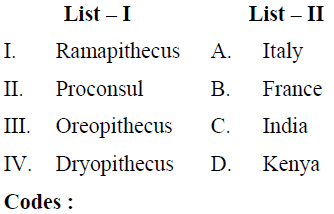
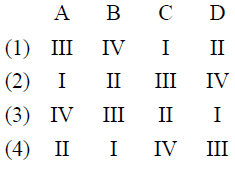
42. Match items in List – I with items in List – II. Use the codes given below :

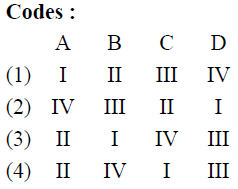
43. Match items in List – I with items in List – II. Use the codes given below :

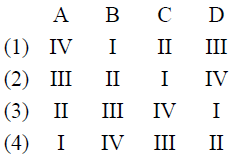
44. Match items in List – I with items in List – II. Use the codes given below :

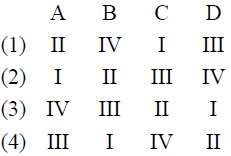
45. Match items in List – I with items in List – II. Use the codes given below :

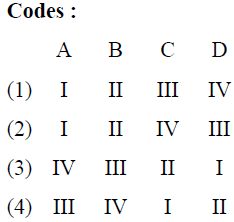
46. Match items in List – I with items in List – II. Use the codes given below :
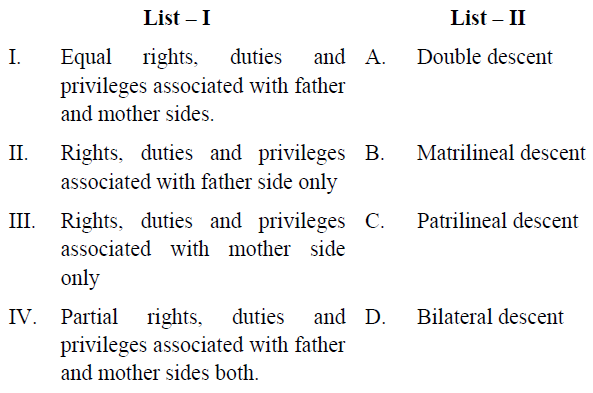
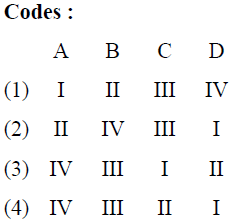
47. Match items in List – I with items in List – II. Use the codes given below :
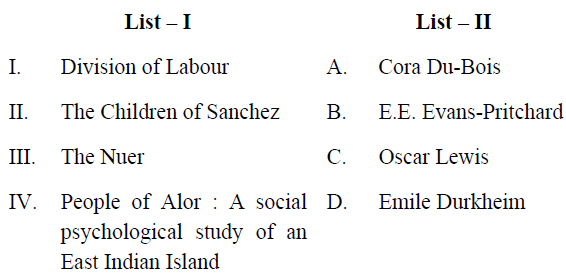
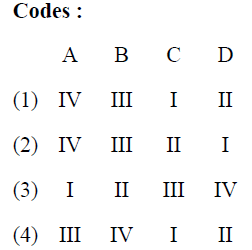
48. Match items in List – I with items in List – II. Use the codes given below :

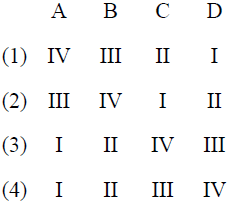
49. Match items in List – I with items in List – II. Use the codes given below :

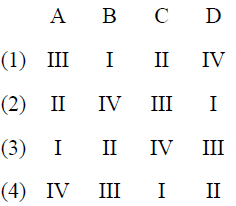
50. Match items in List – I with items in List – II. Use the codes given below :
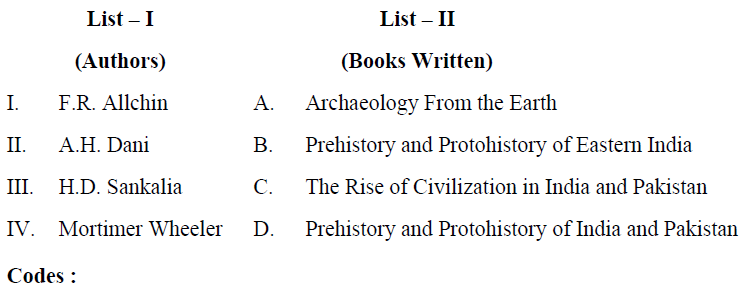
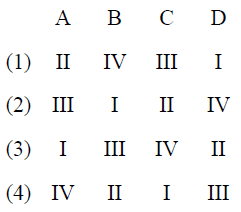
Latest Govt Job & Exam Updates: